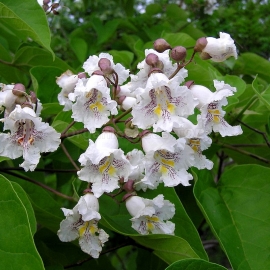







Organic Cigartree Seeds (Catalpa Bignonioides)
1.14 €
The Catalpa has the distinction of bearing some of the showiest flowers of all the American native trees. Its value in this respect has long been recognised and it holds an assured place in the parks and gardens of all temperate countries.
-
Organic Cigartree (Catalpa Bignonioides)
Originally from the south east of the USA it is considered native to Alabama, Florida, Georgia and Louisiana. It is now widely grown as an ornamental tree.
The Catalpa has the distinction of bearing some of the showiest flowers of all the American native trees. Its value in this respect has long been recognised and it holds an assured place in the parks and gardens of all temperate countries. It's size can be controlled by pruning and it makes an excellent pollarded shade tree.
The leaves are large and heart shaped, being 20-30 cm long and 15-20 cm broad. The flowers are 2.5-4 cm across, trumpet shaped, white with yellow spots inside; they grow in panicles of 20-40 individual flowers. The fruit is a long, thin bean like pod 20-40 cm long and 8-10 mm diameter; it often stays attached to tree during winter. The pod contains numerous flat light brown seeds with two papery wings.
The trees are fairly free from fungal diseases and it has few insect enemies, The wood is brittle and hard and does not rot easily. Despite it's southern origins it is a hardy tree to temperatures well below -20 Celsius. It prefers moist soil and full sun and is easily raised from seeds.
How to Grow
Indian Bean Tree seeds are relatively easy to germinate and grow. The dormancy within the seed is short and easily broken. The seeds first need to be soaked in water for 24 hours then drained and mixed with a little dry sand which helps greatly to separate them from each other and make sowing them much easier.
Fill your chosen container with a good quality general potting compost. Suitable containers could be plant pots, seed trays or plug trays or even improvised containers with drainage holes. Firm the compost gently and sow the seeds on the surface -they must have light to enable germination, follow this with a gentle watering.
To maintain enough humidity around the seeds it is necessary to cover them with something transparent, this could be as simple as a clear plastic bag secured with an elastic band for seeds sown in plant pots or could be a sheet of glass or a layer of plastic film (cling film) held off the compost surface using thin wire arches for seeds sown in seed trays. After a day or so the water vapour begins to condense on the inside if the film indicating 100% humidity inside and the correct conditions for surface sown seed to germinate.
Usually within a week kept at room temperature signs of germination are evident. After another week or so covered by the film the edges were lifted slightly to increase air circulation and start to prepare the seedlings for life under more normal conditions
Developing seedlings should be fine in full sun, keep them well watered and free of competing weeds. Growth is quite fast will accelerate greatly during the second and subsequent years Developing young trees should be re-potted as necessary preferably during the dormant season.
